Brachoria mendota
The Mendota Mimic Millipede
Paul MarekCharacteristics
Brachoria mendota individuals are about 40.1 mm long and 9.9 mm wide (females 41.2 mm X 10.6 mm). Color: 3-spotted yellow (shown above) or red; 2-spotted yellow or red (shown above); and 4-spotted yellow . There are regional differences in coloration between three areas: Valley and Ridges, Cumberland Mountain, and Jefferson County, Tennessee. In the Valley and Ridges, individuals tend to be smaller and 2-spotted red; whereas, in the Cumberland Mountain area, individuals tend to be larger and 3-spotted or 4-spotted yellow. An apparently disjunct population was recently discovered in Jefferson County, Tennessee with 2-spotted red or yellow coloration and wider metatergites than average for northern individuals in Virginia.

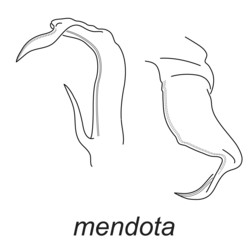
Brachoria mendota genitalia - left male gonopodal acropodite (with setae removed): (Left) medial view and (Right) magnified apical view. © Paul Marek

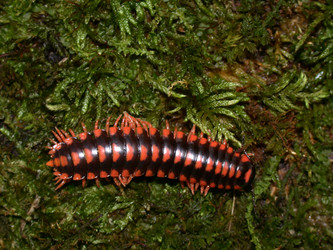
Brachoria mendota, 3-spotted red color morph. © Paul Marek

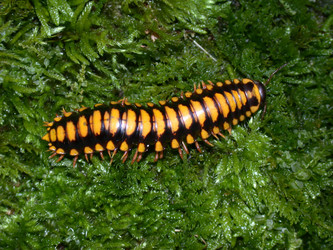
Brachoria mendota, 4-spotted yellow color morph. © Paul Marek

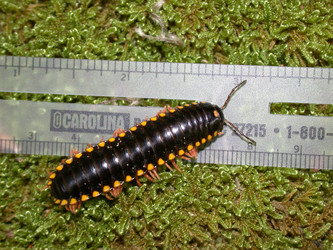
Brachoria mendota, 2-spotted yellow color morph. © Paul Marek
Habitat
Brachoria mendota is common in the Appalachian mixed mesophytic deciduous forests of Virginia and Tennessee. Near the type locality, individuals were collected from a maple and oak forest with a understory of Impatiens and Urtica on a steep slope from beneath decaying leaves. Many other xystodesmids co-occur with B. mendota. Note: Individuals of B. mendota may easily be confused in the field with Apheloria virginiensis corrugata, Rudiloria kleinpeteri, B. cedra, and B. dentata due to similarity in color patterns.Distribution
Known from southwestern Virginia and northeastern Tennessee on Clinch Mountain, northwest through Wallen and Powell mountains, to Pennington Gap in Lee County Virginia. There is one, apparently disjunct population 80 air km west in Jefferson County, Tennessee. Brachoria mendota was previously only known from Clinch Mountain from Fugate Gap in Russell County to Gate City in Scott County in Virginia; however, I discovered a population in Jefferson County, Tennessee, 80 km southwest of the nearest known population at Flat Gap in Scott County, Virginia. Later, populations were found at Pennington Gap, Virginia southeast to Snake Hollow on Newman’s Ridge in Tennessee. Brachoria mendota co-occurs with B. cedra and B. dentata forming a component of a Müllerian mimicry ring with them.Conservation status
Brachoria mendota is threatened by habitat loss due to agriculture (especially growing demand for paper products), coal mining, development, and the invasion of exotic species.References
Marek P.E. 2010. A revision of the Appalachian millipede genus Brachoria Chamberlin, 1939 (Polydesmida: Xystodesmidae: Apheloriini). Zool. J. Linn. Soc. 159: 817-889.
Marek P.E., Bond J.E. 2006. Phylogenetic systematics of the colorful, cyanide-producing millipedes of Appalachia (Polydesmida, Xystodesmidae, Apheloriini) using a total evidence Bayesian approach. Mol. Phylogenet. Evol. 41: 704-729.
Marek P.E., Bond J.E. 2007. A reassessment of apheloriine millipede phylogeny: additional taxa, Bayesian inference, and direct optimization (Polydesmida: Xystodesmidae). Zootaxa 1610: 27-39.
Keeton W.T. 1959. A revision of the millipede genus Brachoria (Polydesmida: Xystodesmidae) Proc. US Nat. Mus. 109: 1-58.
Hoffman R.L. 1999. Checklist of the millipeds of North and Middle America. Virginia Museum of Natural History Special Publication. No. 8. Martinsville: Virginia Museum of Natural History.
Title Illustrations

| Scientific Name | Brachoria mendota |
|---|---|
| Location | USA, Virginia, Russell Co. |
| Reference | Marek P.E. 2010. A revision of the Appalachian millipede genus Brachoria Chamberlin, 1939 (Polydesmida: Xystodesmidae: Apheloriini). Zool. J. Linn. Soc. 159: 817-889. |
| Specimen Condition | Live Specimen |
| Sex | m |
| Life Cycle Stage | adult |
| View | dorsal |
| Collection | FMNH |
| Collector | Paul Marek |
| Image Use |
 This media file is licensed under the Creative Commons Attribution-NonCommercial License - Version 3.0. This media file is licensed under the Creative Commons Attribution-NonCommercial License - Version 3.0.
|
| Copyright |
© Paul Marek

|
| Scientific Name | Brachoria mendota |
|---|---|
| Location | USA, Virginia, Lee Co. |
| Reference | Marek P.E. 2010. A revision of the Appalachian millipede genus Brachoria Chamberlin, 1939 (Polydesmida: Xystodesmidae: Apheloriini). Zool. J. Linn. Soc. 159: 817-889. |
| Specimen Condition | Live Specimen |
| Sex | m |
| Life Cycle Stage | adult |
| View | dorsal |
| Collection | FMNH |
| Collector | Paul Marek |
| Image Use |
 This media file is licensed under the Creative Commons Attribution-NonCommercial License - Version 3.0. This media file is licensed under the Creative Commons Attribution-NonCommercial License - Version 3.0.
|
| Copyright |
© Paul Marek

|
About This Page
Work on the millipede Tree of Life pages was supported by a U.S. National Science Foundation Doctoral Dissertation Improvement Grant to Paul Marek and Jason Bond (DEB 0607996) and a Partnerships for Enhancing Expertise in Taxonomy Grant to Petra Sierwald, Jason Bond, and William Shear (DEB 0529715).
Paul Marek

Virginia Polytechnic Institute and State University
Correspondence regarding this page should be directed to Paul Marek at
brachoria@gmail.com
Page copyright © 2010 Paul Marek
 Page: Tree of Life
Brachoria mendota . The Mendota Mimic Millipede.
Authored by
Paul Marek.
The TEXT of this page is licensed under the
Creative Commons Attribution-NonCommercial License - Version 3.0. Note that images and other media
featured on this page are each governed by their own license, and they may or may not be available
for reuse. Click on an image or a media link to access the media data window, which provides the
relevant licensing information. For the general terms and conditions of ToL material reuse and
redistribution, please see the Tree of Life Copyright
Policies.
Page: Tree of Life
Brachoria mendota . The Mendota Mimic Millipede.
Authored by
Paul Marek.
The TEXT of this page is licensed under the
Creative Commons Attribution-NonCommercial License - Version 3.0. Note that images and other media
featured on this page are each governed by their own license, and they may or may not be available
for reuse. Click on an image or a media link to access the media data window, which provides the
relevant licensing information. For the general terms and conditions of ToL material reuse and
redistribution, please see the Tree of Life Copyright
Policies.
- First online 16 September 2010
- Content changed 16 September 2010
Citing this page:
Marek, Paul. 2010. Brachoria mendota . The Mendota Mimic Millipede. Version 16 September 2010 (under construction). http://tolweb.org/Brachoria_mendota/144229/2010.09.16 in The Tree of Life Web Project, http://tolweb.org/




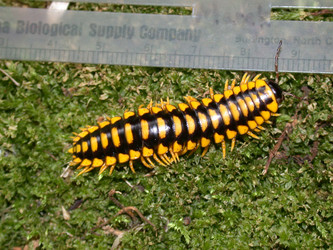
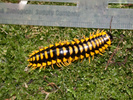


 Go to quick links
Go to quick search
Go to navigation for this section of the ToL site
Go to detailed links for the ToL site
Go to quick links
Go to quick search
Go to navigation for this section of the ToL site
Go to detailed links for the ToL site